In the wild Bearded Dragon lizards are omnivores, and they prefer to eat a mixture of insects, vegetables, and fruits. On the other hand, a pet lizard lives in a different condition, so his diet is a whole other story, yet you must make sure to keep it versatile so your lizard will stay healthy.
If you have never owned a pet before, you must keep in mind that feeding juveniles and babies are not the same; they should be fed different diets as they grow. At first glance, this all can seem complicated, but do not fret; even first-time reptile owners can easily master their diet and proper nutrition in no time.
I will explain to you everything you need to know about what can bearded dragons eat, so keep on reading.

What Food Should Bearded Dragons Eat?
Pet Beardies must have a very diverse diet so they can obtain their optimal health condition. You should make sure they eat insects, small vertebrates, greens, veggies, and fruits. They are not very picky eaters, but of course, this does not mean you can just grab any veggie or fruit, or insect and feed your precious reptile.
In the wilderness, they are agile hunters; they hunt their prey and crush it with their strong jaws every day; they mainly eat insects and small animals, which make up about 75% of their diet; the other 25% consists of greens. When they are kept in captivity, they should be fed only once per day.
There are many different types of insects, fruits, and veggies that are safe to feed your Beardie, but in the list below are listed those that are nutritionally the best.

What Meat Can Bearded Dragons Eat?
Bearded Dragons can eat meat in the form of live insects, and below is the list of recommended protein sources you should include in their diet:
- Crickets
- Cockroaches
- Locusts
- Dubia roaches
- King worms
- Waxworms
- Earthworms
- Butterworms
- Silkworms
- Phoenix worms
- Mealworms (only feed adult Bearded Dragons with these insects since they have hard outer skin)
- Super worms (these are a larger version of mealworms suitable for adults only)
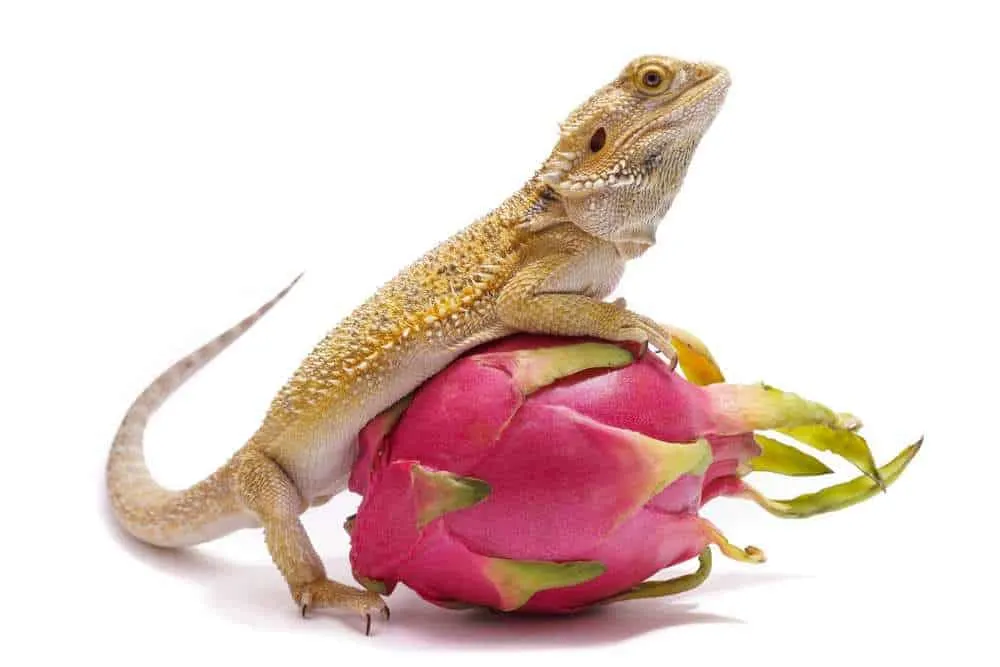
Which Fruits Can Bearded Dragons Eat?
The fruit is an excellent source of nutrients for Beardies but make sure you feed them with soft fruits with caution (once per month) since they can cause teeth problems due to the high sugar content.
Beardies can eat a wide variety of fruits such as:

What Veggies Are Suitable For Feeding A Bearded Dragon?
They can munch on a wide variety of vegetables. Here is the comprehensive list:
- Peas
- Green beans
- Courgette
- Yellow squash
- Butternut squash
- Acorn squash
- Sweet potato
- Peppers
- Okra
- Broccoli (small pieces every week)
- Cabbage
- Bok choy
- Kohlrabi
- Parsnip
- Asparagus
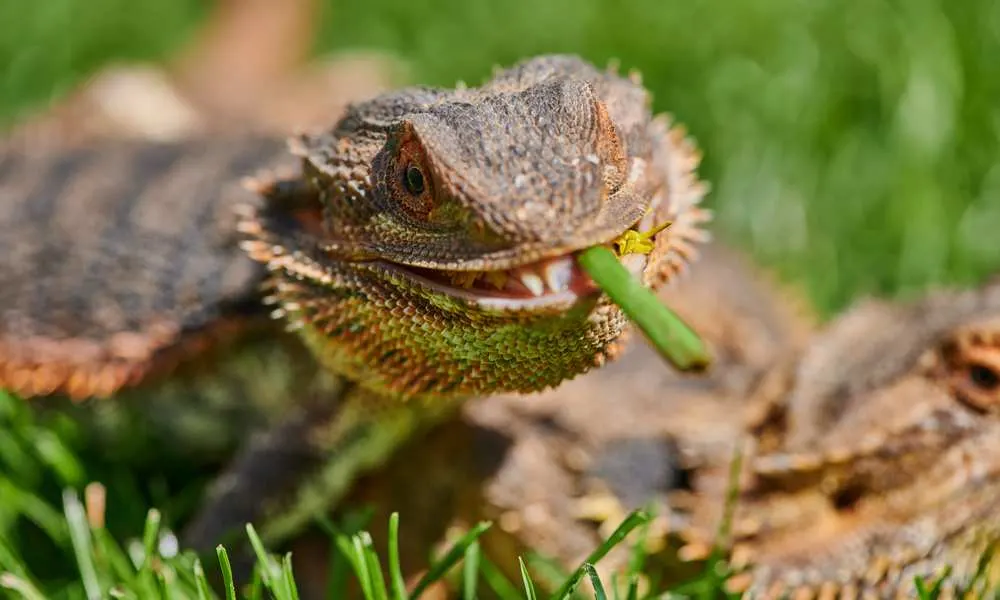
What Leafy Greens Can Bearded Dragons Eat?
Beardies can eat greens. Our food list tells you what greens they can eat:
Some foods are not included in the lists above, but you can feed your Beardie with them from time to time. Those are:
See Also: Can Bearded Dragons Eat Alfalfa Sprouts?
Some food must be prepared before feeding like some fruit and veggies must be peeled and cut into bite-size pieces. Make sure live insects do not drown in the water bowl since they won’t eat them then; if this happens, clean them out asap and offer new ones.
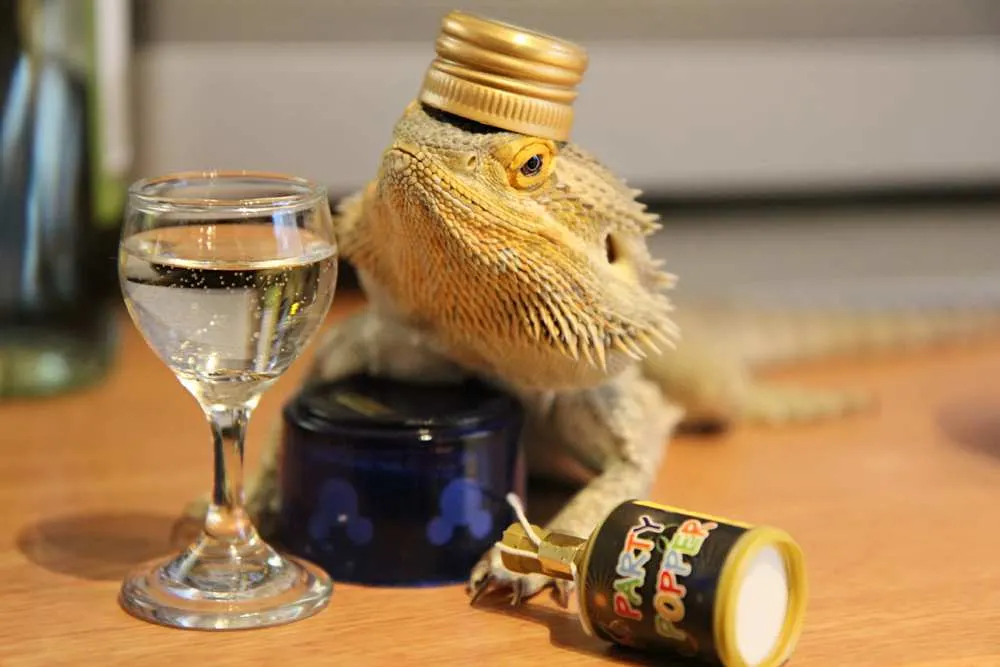
What Food Your Bearded Dragons Can’t Eat?
Some foods should never be included in your Beardies diet. You are responsible for what they eat, so make sure they never come in close contact with them since they will eat everything that comes in their way.
Those foods are:
- Iceberg lettuce and celery are mostly water and have almost no nutritional value, so don’t let your Bearded Dragon eat it
- Spinach and beet tops these foods contain chemicals that can cause calcium deficiency, which can lead to metabolic bone disease
- Insects captured in the wild may have parasites in them that can harm your pet
- Fireflies, any insects that glow, are toxic and can kill the reptile
- Fish and prawns
- Garlic and onions
- Spiders and ticks
- Oranges or any other citrus fruits since they are too acidic for them and can cause stomach issues
- Avocados have chemicals that are toxic for Beardies, even a small amount will make your reptile ill, and a large portion can be lethal
- Beef and chicken
- Eggplant
- Rhubarb has high levels of oxalic acid that can be deadly poisonous for your reptile.
- Wild plants like daffodil, holly, horse chestnut, ivy, oak, poppy, buttercup, bracken fern, crocus are all toxic for reptiles
- The sand, of course, you won’t feed your Beardie with sand, but many users like to use sand as a substrate, and often it ends up in their food. The problem is that sand causes impaction since it can’t be digested and causes a blockage that can be fatal
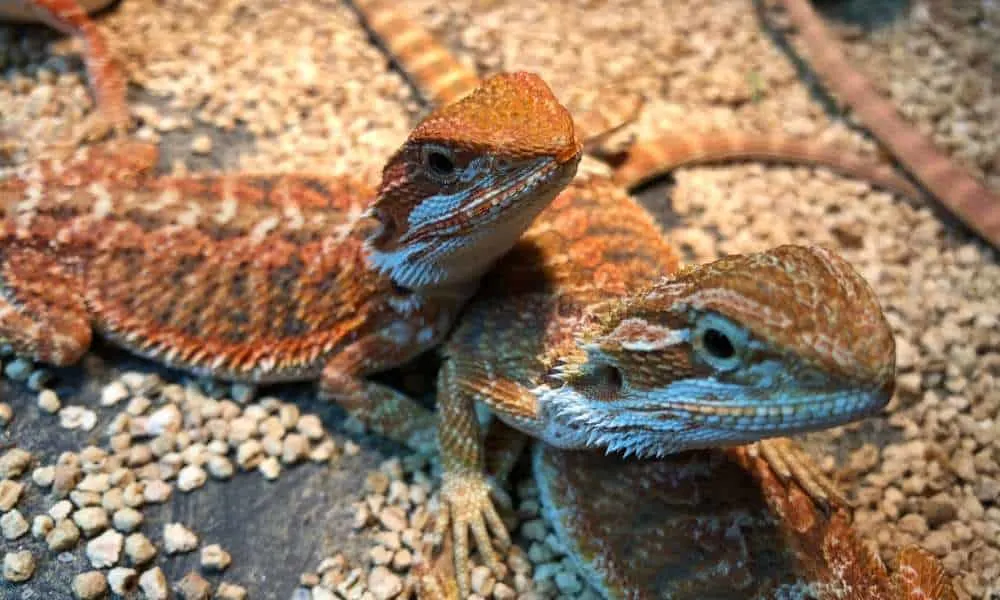
How To Feed Your Beardie According Their Life Stages?
Juveniles rapidly grow, so they require more protein and should be fed three times a day. Their diet should mostly consist of insects.
On the other hand, as they grow, the adults should eat fewer insects and more fruits and vegetables since they are not getting much exercise, so higher protein intake can lead to obesity.
Formulating their diet can be overwhelming for beginners, so always track their food intake by using a feeding chart. Keep in mind how important it is that adults, juveniles, and hatchlings receive the correct food and nutrients to properly grow and stay healthy.
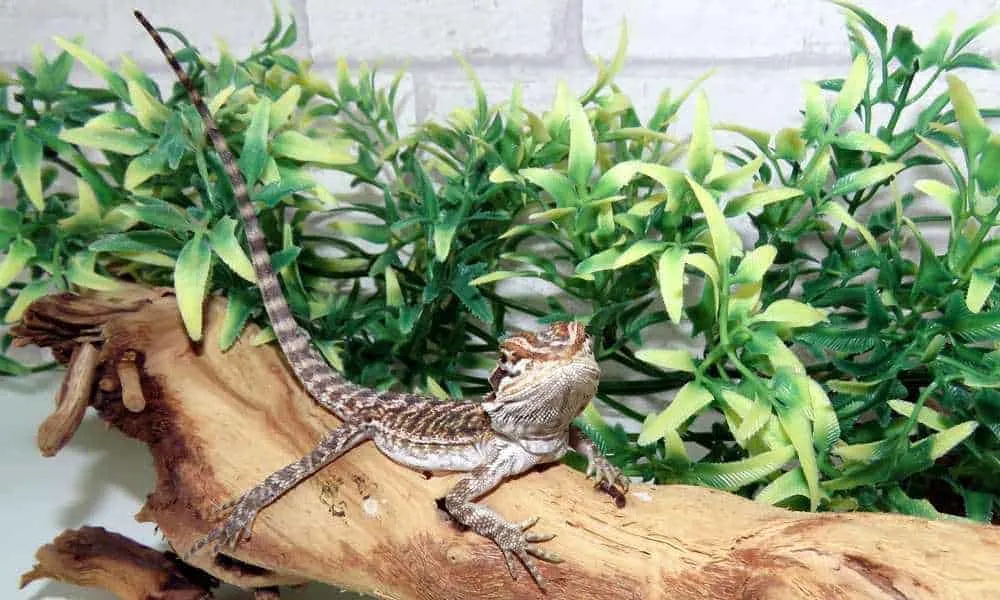
Baby Beardie Feeding Schedule
Young Bearded Dragons grow very quickly and need lots of protein, the best ratio of protein to greens, veggies, and fruits should be 75/25 in favor of meat.
Baby Beardies will need to eat more insects than vegetables, and they will need to be fed more often than adults. They should be fed up to three times a day. In the first two months, baby Bearded Dragons will need to be fed crickets throughout the day.
Baby Dragons can eat up to 60 insects a day. But usually, they don’t, and they stop eating when they are full during that 10 to 15 minute feeding period. Remove the remaining insects and wait to feed them again in a few hours.
Always leave vegetables and greens in their cage so they can munch on them whenever they want between those three 10 – 15 minute feeding periods. As they grow, feed them less often until they reach two months. In this stage of their life, they should be fed there time a day.
Take this table as an example.
| Protein | Veggies and Greens | Fruit | |
|---|---|---|---|
| Day 1 (pm) | 10 crickets | 2 small kale leaves 1 small piece of pumpkin | 1 blueberry |
| Day 1 (noon) | 10 Dubia roaches | 2 small collard green pieces 1 small squash piece | 1 small slice of peach |
| Day 1 (am) | 10 crickets | 2 small dandelion green pieces 1 small piece of bell pepper | 1 blackberry |
| Day 2 (pm) | 10 Dubia roaches | 2 small kale leaves 1 small pumpkin piece | 1 blueberry |
| Day 2 (noon) | 10 crickets | 2 small collard green pieces 1 small squash piece | 1 small slice of peach |
| Day 2 (am) | 10 Dubia roaches | 2 small dandelion green pieces 1 small piece of bell pepper | 1 strawberry |
It is essential to cut up any greens, vegetables, and fruits into bite-sized pieces prior to feeding, and those pieces should be no bigger than the distance between your pet’s eyes. If you feed them with larger pieces, you risk gastrointestinal issues.
Beardies reach adult size at 18 months, and this is when they become less active; when this happens, cut their protein intake gradually until they transition to an adult’s diet.
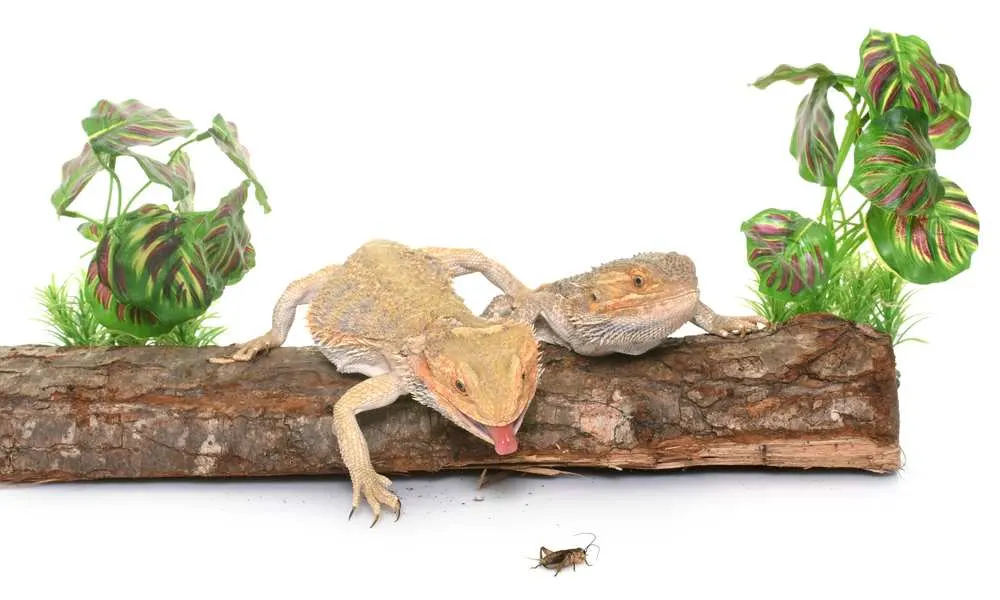
Juvenile And Adult Bearded Dragon Feeding Schedule
Adults and juveniles should be fed once a day. The rule is that the diet of captive Beardies should mimic the diet of the ones that live in the wilderness, but this is not so true.
Bearded Dragons that live in the wild are very active even when they are old since they need to hunt for food, so they need a higher protein intake than those that are kept as a pet.
Some say that a feeding ratio of 50/50 is okay, but this mainly depends on how active your Beardie is. If your reptile is older and not very active, feeding him 75% greens, vegetables, and fruits and 25% insects and vertebrates are more than enough.
It is vital to vary the types of foods, so they stay interested.
Here is an example.
| Protein | Veggies and Greens | Fruit | |
|---|---|---|---|
| Day 1 | 5 Crickets 5 Dubia roaches | 2 Sweet potato pieces 2 Bell pepper slices Kale Collard greens | 3 Blueberries 1 Strawberry |
| Day 2 | 5 Super worms 3 Earthworms | 2 Baby carrots 2 Pumpkin pieces Dandelion greens Bok choy | 2 Peach slices |
| Day 3 | 5 Crickets 5 Dubia roaches | 2 Sweet potato pieces 2 Bell pepper slices Kale Endive | 3 Blueberries 1 Blackberry |
| Day 4 | 5 Super worms 3 Earthworms | 2 Pumpkin pieces 2 Asparagus pieces Cabbage Rocket | 2 Apricot slices |
If you’re planning to give your juvenile Beardie a premium protein source, you must stick to recommended portions.
For juveniles from 4-9 months:
- 40-50 smaller nymph Dubias per day
- 8-12 super worms once a day
- 50-100 phoenix worms per day
For juveniles 9 months and more:
- 10-20 nymph Dubias per day
- 5-7 super worms every other day
- 50-75 phoenix worms per day
If you want, you can chop vegetables and fruits weekly and then freeze them and thaw this mix in the microwave before feeding; greens should always be offered fresh. If your dragon refuses to eat, remove it after an hour and prevent them from eating spoiled food. Greens are okay to stay.
If they start to refuse food or eat less than normal, consult your vet.

How To Transition To A New Diet Regime?
Now that you know why and when you need to change up your pet dragon diet, it is time to reveal what is the best way to do it. Beardies are not picky eaters usually; however, sometimes they can become grumpy when they are forced to eat something they don’t like or don’t know.
That is why you’ll want to make sure you really ease them into eating new foods. You can’t just all of a sudden cut their protein down to 20% overnight and expect them to eat a ton of veggies without any protest! If you do so and succeed, you can consider yourself very lucky.
The best approach is to slowly cut the protein intake in the period of a few months up to a year and replace it with more veggies as your pet grows older. Spice up the things by throwing in some of their favorite fruit or greens just to make a diversion.
Experiment a bit since you can’t know which food ingredient will be the “IT” for your Beardie.
It is just like with kids; the moment you introduce the good stuff into their diets, such as super worms and Dubia roaches, you can expect them frowning at simple yet good old crickets.
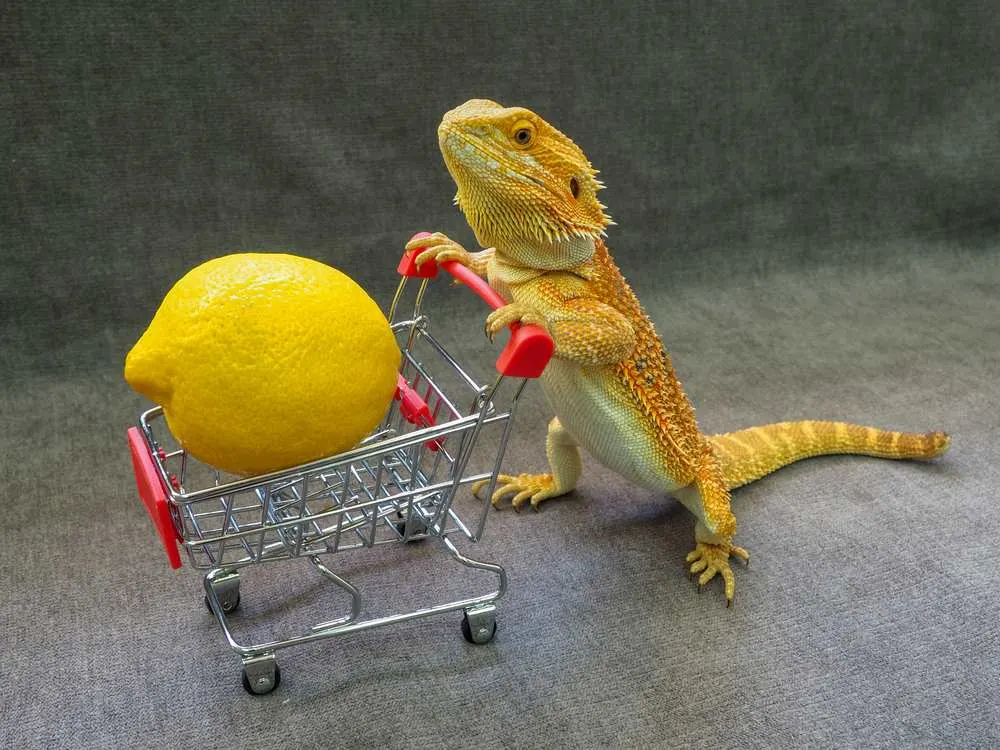
Vitamins And Calcium Supplements In Diet
Calcium deficiency is a very common problem among reptiles, and it can lead to metabolic bone disease. This is why their diet must be rich and varied, but this is not enough; they will need to be supplemented with vitamins and calcium to stay healthy.
The easiest way is by buying calcium and multivitamin powders and sprinkling them over their food twice a week at least but never mixing them. Use the calcium powder one day and use the multivitamin powder the next day, then go back to calcium and so on.
Baby Bearded Dragons under six months will need supplements daily, and as they grow, you can lower the number of supplements they eat. Dragons between 6 months and one year should use supplements every other day. Adults over one year should have calcium, and D3 mix served every 2 or 3 days and vitamins twice a week.

Iron
Iron is most important for baby Beardies since it helps with development. Usually, adults receive enough iron from the veggies they eat. The problem is that babies and juveniles may not always eat their greens, so supplementation is a must. Crickets are a great source of iron but if they need more, provide them with powder iron supplements the same way as you do with calcium and multivitamin.

Phosphorus
Phosphorus is crucial for bone development. Fruits and veggies in their diet will provide enough phosphorus. That is why you should monitor your Beardies’ calcium-to-phosphorus levels and make sure they are receiving the right amount of both nutrients.
If your bearded dragon’s diet is high in phosphorus, you need to use multivitamins that are phosphorous-free, considering that too much phosphorus will prevent the digestion of calcium. The ideal level is 1.5:1 in favor of calcium, but levels such as 1:1 to 2:1 Ca:P are good as well.
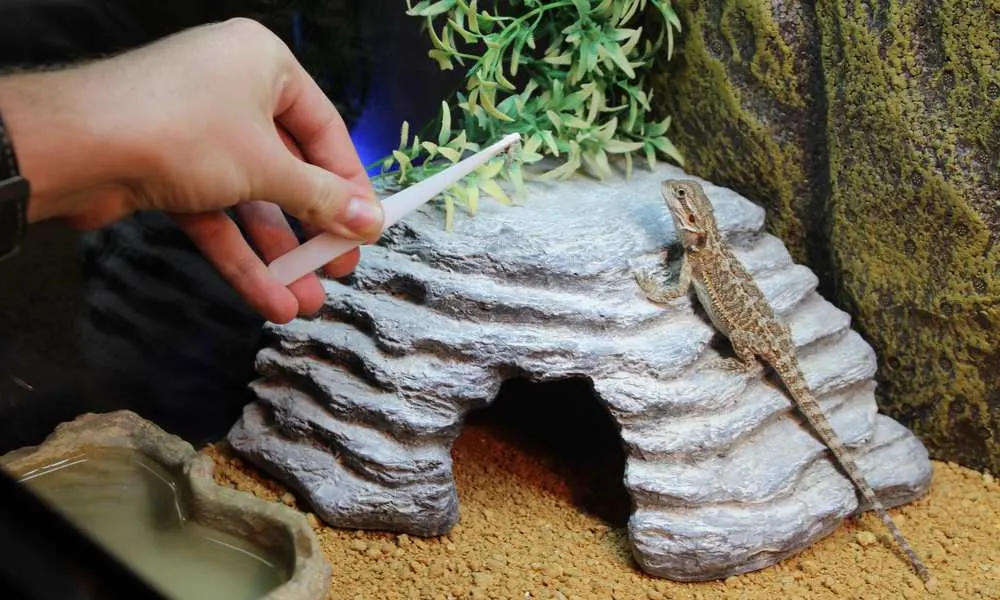
What To Do If Your Beardie Is Refusing To Eat?
The most common reason is temperature changes if the temperature setting is too high or low. If they are not eating, first check the temperature. There must be a basking area with a temperature from 35 to 43 degrees Celsius and a cool-down area with 27 to 32 degrees Celsius.
There are some other reasons such as:
- Impaction caused by ingesting loose substrate like sand
- Food pieces are too big
- Shedding skin will make them stop eating for a short period
- Parasites
- Stress
- Brumation is a hibernation-like state that Bearded Dragons enter into in the colder months
Refusing food doesn’t immediately mean your pet is unwell. Sometimes Bearded Dragons do not eat for a day if they feel full, or if they are too hot, they will only crave water. In case you notice that your reptile is losing weight, then it is a time for concern.
If you notice symptoms that include diarrhea, a lack of energy, droopy or swollen eyes, go to the vet as soon as possible.
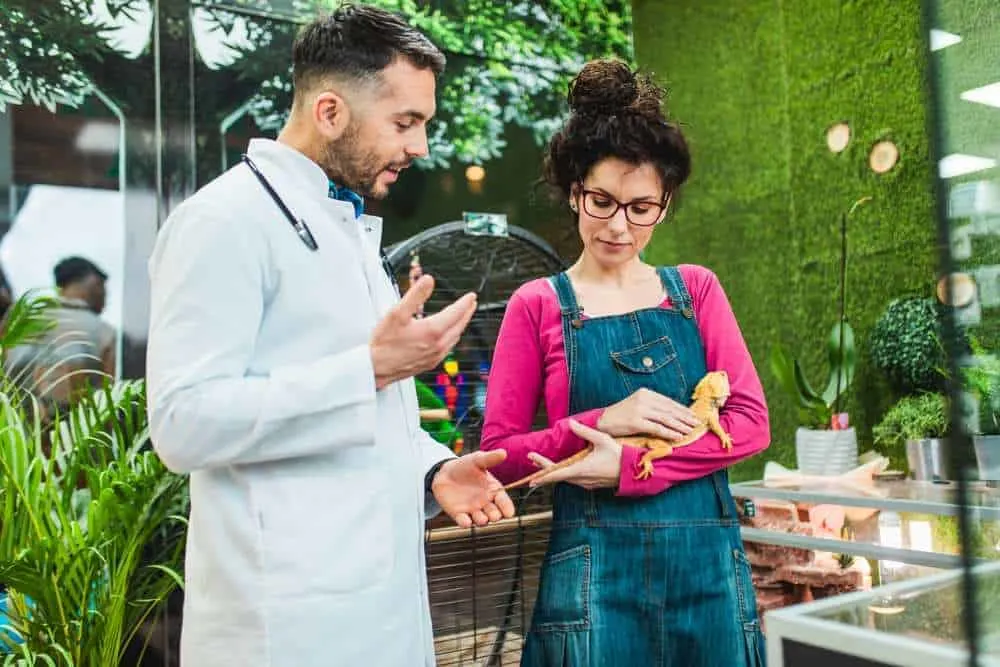
How to feed an ill Bearded Dragon?
If they are diagnosed with an illness, the vet will usually recommend a specific diet which you must always follow.
In case the vet did not recommend any diet, there are methods of feeding that can help with certain conditions. In case they are dehydrated, you need to cut out solid foods into tiny, tiny pieces. Always use a syringe to drop an electrolyte solution near or on their mouth in case of dehydration.
If they still refuse to eat foods, no matter how small the pieces are, you can create a watery mix of food and nutrients and feed it to them with a syringe. From that point, you will be able to slowly build up to solid foods back again.

Three Common Feeding Mistakes
These three common feeding mistakes can lead to a variety of health issues and obesity.
The first mistake is overfeeding, which leads to obesity, which is very common among adult Beardies. Like most reptiles, they have a healthy appetite, and they will eat all the available food, so make sure you are rational with portions. This means that an adult should not have more than twenty insects a day.
Obesity is a major health issue that can lead to heart disease and joint issues.
The second most common feeding mistake is giving juveniles mealworms.
Feeding juvenile Beardie with large insects such as mealworms can stunt their growth and prevent them from receiving the nutrients they need for proper development.
As already mentioned, mealworms have a hard outer shell made up of chitin that juveniles can’t digest, so they do not receive all the nutritional ingredients from it.
Avoiding gut loading is the third most common mistake. Gut loading is feeding insects fruits and veggies that are dense with nutrients before offering them to your pet reptile. This process is important since it enhances the nutritional values of insects. It is important to gut load the insects at least a day before feeding.

Hydration
Bearded Dragons naturally live in very hot and dry climates meaning they are adapted to survive on very little water. However, this does not mean they should live in minimal amounts of water. Hydration is an important issue.
Your Beardie will receive most of its water from plants and vegetables that he eats. However, a tank where your Bearded Dragon is living is hot and dry, so it does not take long for the greens to become dehydrated, so alternative supplies of water are highly recommended.
Some put water dishes in their enclosure; however, since they come from desert environments, they don’t recognize standing water that easily, and in most cases, they won’t drink from their water bowl.
It is more likely that you will catch them soaking in the water bowl instead of drinking from it. Soaking is normal behavior for them, and it helps with digestion. The problem is that they often urinate or defecate while they soak, so change it regularly.
An alternative is to mist your pet dragon with fresh water once or twice a day with a spray bottle. In nature, reptiles drink the dew and raindrops for hydration, so misting will recreate this environment. Make sure you mist your Beardie when they begin to shed since the hydration will help moisturize their skin and ease up the shedding process.
Soaking your dragon while you supervise is not a bad idea; frequent baths, three or more times a week, will help with hydration. Most Beardies will drink the water during bathing, so make sure it is always fresh.
If you decide to bathe your reptile in a sink, clean it thoroughly to remove all the chemical residue before placing it in for a bath. Also, it is crucial to clean it well afterward because bearded dragons can carry Salmonella.
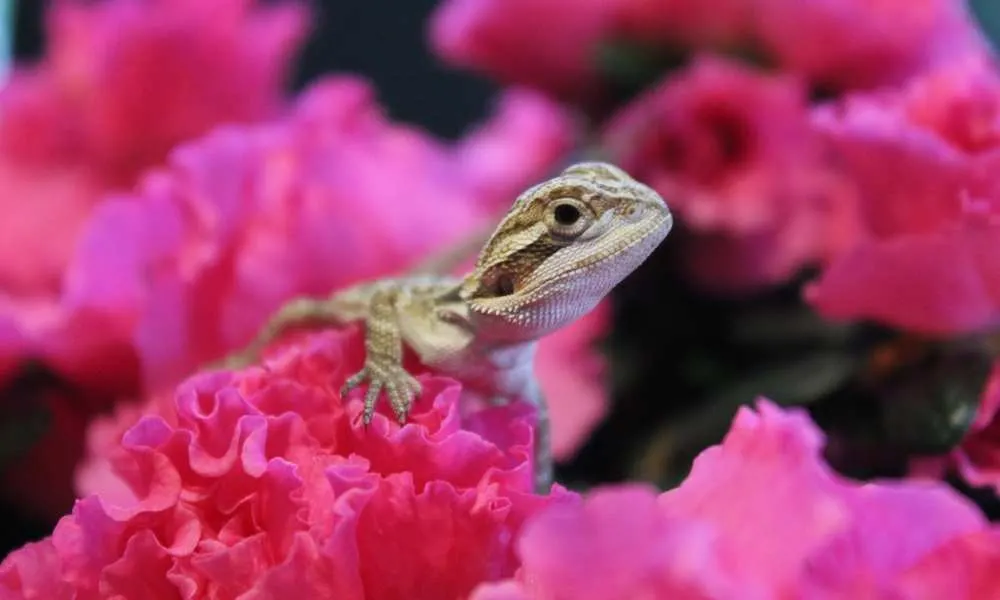
It Is Time To Sum Things Up
Reptiles are getting very popular lately, and Bearded Dragons are one of the most common choices among reptile enthusiasts. They are easy to maintain, easy-going, not aggressive, and cute. They just wanna bask in the warmth and chill out. Who does not want to hang out with those guys!
However, ensuring a good diet is fundamental to keeping your pet dragon in a good mood and health. Learning to feed baby reptiles properly, juvenile reptiles, and adult reptiles is the key secret. Keep in mind that the older they get, the less active they are, and you must cut the protein intake to prevent obesity. Transition to an adult diet should occur when they reach a year and a half, not before that.
When you are a first-time owner of a reptile, things get very confusing, and you will get frustrated and disappointed more than you can think. You will expect your Beardie to love some new food ingredient that you bought for them with so much excitement and only to find out that he or she won’t even look at it.
But don’t despair after some time, you will figure out the best diet and feeding routine, and everything will be peachy. I hope you will find this article helpful.
Until the next reading.

